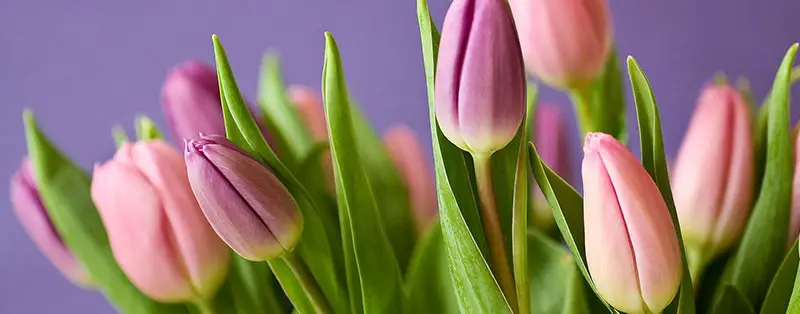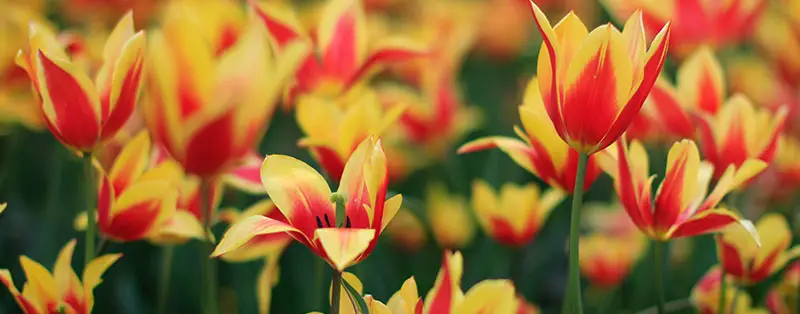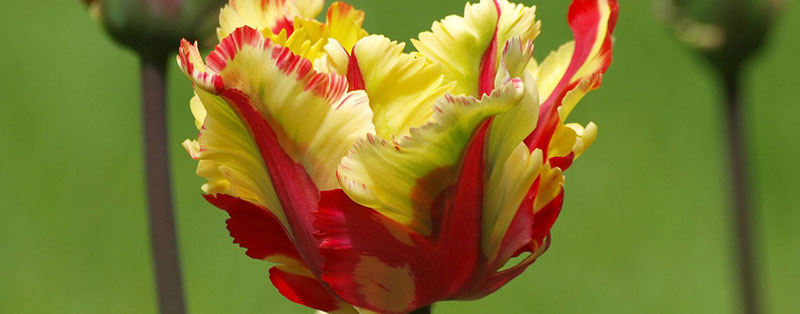Tulips come in almost all of the colours of the rainbow. Red, orange, yellow, pink, purple, green, but also in white and almost black which is actually a very dark purple. The color blue however is missing, because a blue tulip simply does not exist. But who knows, it might be possible in the future.
For now, there is still plenty of choice, not only in colour but also in types of tulips available. There are tulips with serrated flowers, multi-coloured flowers, single or double flowers. Read on and discover everything about the different types and colours of tulips.
Tulip bulbs
The planting of tulip bulbs is during autumn, in the month of October or November. To bloom, tulips need a cold winter with cold nights. To get new tulip bulbs, you can peel the original bulb for that. There are little ‘baby’ bulbs inside them. If you plant them out in autumn, these will grow into good bulbs. The mature tulip bulbs that you plant in autumn, bloom from early April until mid-May, depending on their type.
Buying tulip bulbs
When buying tulips, make sure you buy healthy bulbs. Do not buy bulbs with discolouration, fungus or that have already run out, are soft to the touch or have any other damage. A good tulip bulb should look smooth and feel firm and be undamaged. If you want to store the tulip bulbs for a while before planting them you can put them in a dark and dry place.
Tulipa
You would assume that the tulip comes from the Netherlands, as it is pretty much their national feature. However, this is not the case. The tulip originates from Turkey. The name of the tulip comes from the word ‘Tulipan’, which means turban. With some imagination, you can notice this from the shape of the flower with some imagination. The Netherlands is famous for its cultivated flower bulbs. This makes us one of the most important export countries for tulips and their bulbs. Because of the tulip fields and Keukenhof, tulips attract many tourists in the Netherlands.
Tulip in dutch is Tulp.
Types of tulips
There are many types of tulips, about 75 species and 3000 varieties. They all have their own botanical name. There are tulips named after celebrities, such as Jan des Bouvrie, Annie Schilder and King Willem Alexander.
Tulipa Sylvestris
The forest tulip is the only tulip that you will encounter native to the Netherlands. Judging by the name, you can tell that it likes to grow in the woods. However, this type does need some sun, preferably at least half a day. The forest tulip likes a nutrient-rich soil. It is a yellow-coloured tulip that grows to a height of about 30 centimeters.
Tulips Tarda
A wild tulip with wide open flowers and pointed petals. The color of the petal is yellow with white tips. The height of the wild tulip is about 10 to 15 centimeters. A beautiful species to naturalise in your garden.
Tulipa Turkestanica
A creamy white flower with a yellow heart. The petals are widely spaced and taper to a point. The height of this tulip is around 20 to 25 centimeters and prefers a spot in the sun. The green-grey leaves of the Tulipa Turkestanica are very prominent.
Tulipa Gesneriana
The Tulipa Gesneriana is also known as the garden tulip. The flowers are erect in different colors: red, orange, yellow, white or dark purple. The flower grows up to 50 centimeters high and blooms in April and May.
Tulipa Clusiana
A small and graceful tulip in the colours white and red with star-shaped inflorescence. The height of the flower will be about 25 centimeters. A special type with green-gray pointed leaves. One type flowers in the colours red with yellow.
Tulipa Linifolia
One that fits nicely in a flower meadow. Gracefully shaped with red flowers and a black center. A suitable tulip for on a sunny spot to naturalise. It grows from 10 up to 15 centimeters high and flowers a little later in the tulip flowering period.
Tulipa Saxatilis
A lovely little tulip that flowers easily and enjoys to naturalise. The flower is shaped like a cup with a yellow center and purple stamens. The petals are in a soft lilac-pink color. The tulip flowers in April and grows to a height of 20 to 30 centimeters. It also naturalises easily when put in a spot in the sun or in partial shade.
Tulipa Negrita
A classic tulip with a warm purple color. An excellent cut flower with its long stems. One of the tulips with a longer flowering time. If you plant it in a sunny spot on fertile soil, it will return on an annual base.
Peony Tulip
A double tulip, with well-filled flowers. Due to the multiple petals that it has, the flower increases in volume. The peony tulip is available in different colours; yellow, pink, white, red, salmon or is multi-coloured.
Parakeet Tulip
The parakeet tulip or parrot tulip is a flower with frayed and curled petals. Very special to see and an eye-catcher in your border. With its long flower stems and large flowers, it will certainly stand out. Parrot tulips come in a variety of colours. The black variant is striking and well-known. In addition to many single colours, you also them with multiple colours, for example red with white or red with yellow.
Planting Tulips
Tulips are planted in autumn. After a cold winter and cold nights, the flower will emerge from the bulb in spring. Tulips prefer a sunny spot or a spot in partial shade. The tulip thrives best on fertile soil.
Create a hole in the bottom where you want the tulip, on average 10 to 12 centimeters deep. Check the packaging of the tulip to see how deep the type you have should be planted and how far apart you should plant the bulbs from each other. Tulip bulbs are easy to plant in pots and containers. Eventually seal the hole with soil and be patient so in spring you can enjoy your beautiful flowers.
When to plant Tulips
The tulips should be planted in autumn, in the months of September, October or November. It is best to have the bulbs in the ground already before the first frost.
Care for Tulips
After the tulips have finished their flowering, it is best to leave the foliage on the bulb for as long as possible. The bulb gets the nutrients from it so they can prepare the flowering for the next year. Only remove it when the foliage has died. It is then best to lift the bulbs and let them dry. When they are completely dry, you can store them in a dark and dry place to plant them in the ground again the following autumn. You can also harvest, store and replant the naturalising bulbs that will appear on the existing bulbs this way.













